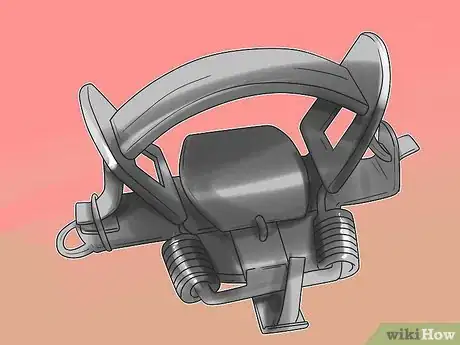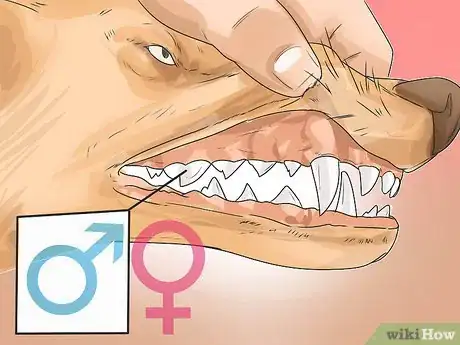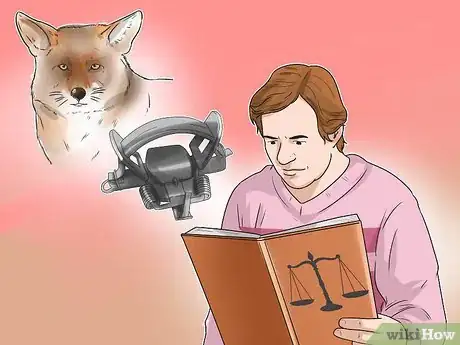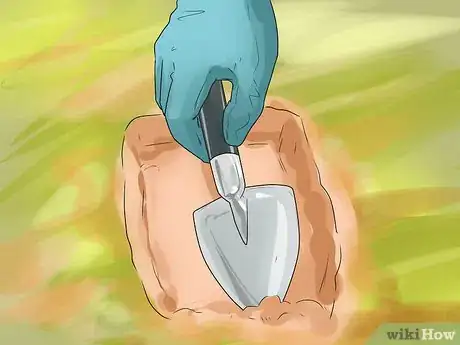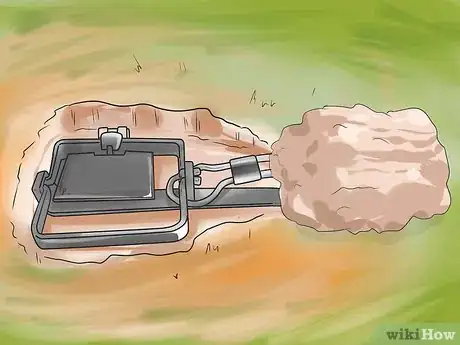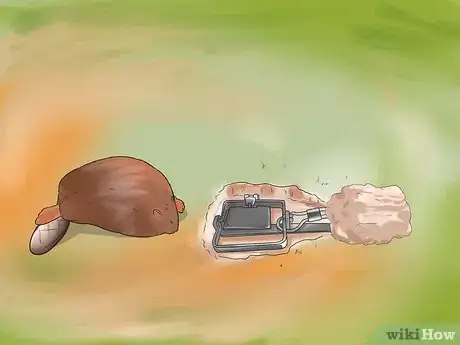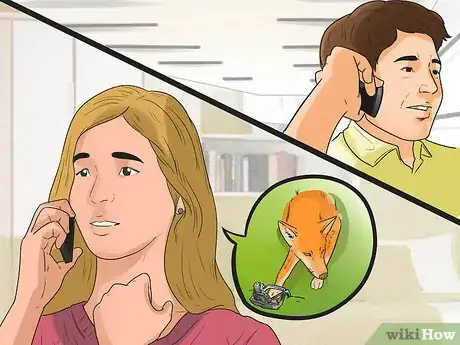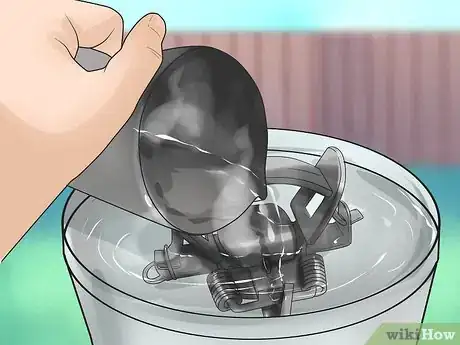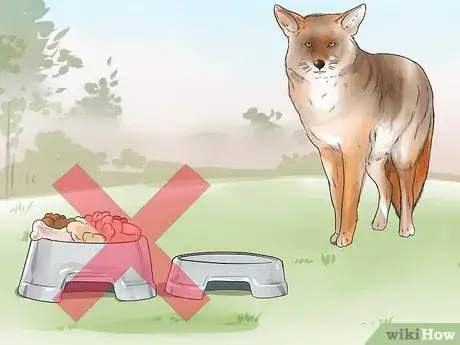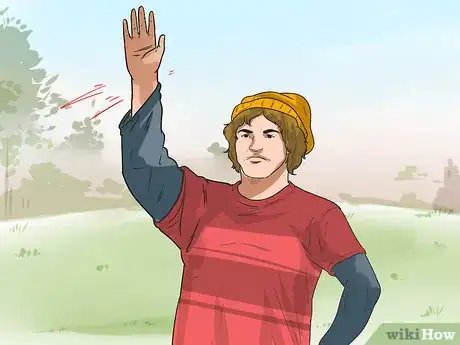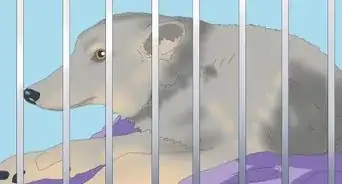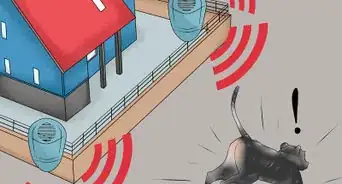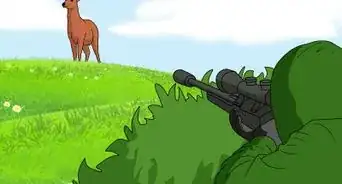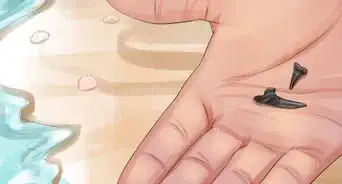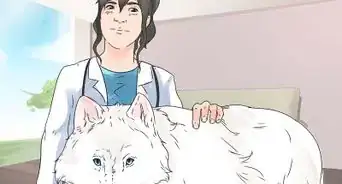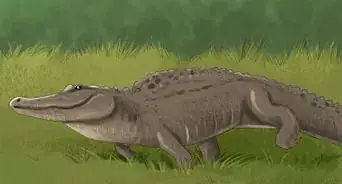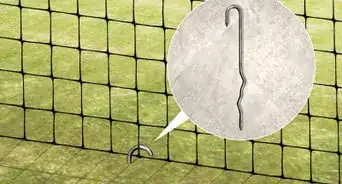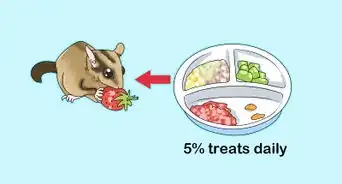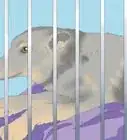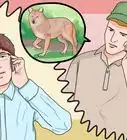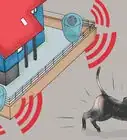wikiHow is a “wiki,” similar to Wikipedia, which means that many of our articles are co-written by multiple authors. To create this article, 35 people, some anonymous, worked to edit and improve it over time.
This article has been viewed 267,864 times.
Learn more...
Although they are important to the ecosystem, coyotes, which are wild canines that are found across North America, can cause problems when they damage or kill domestic pets, like dogs or livestock. Coyotes sometimes also scavenge through garbage. If you are dealing with a nuisance or a destructive coyote, there are ways you can trap the coyote to prevent this from happening.
Steps
Preparing to Trap the Coyote
-
1Use the right trap. Coyotes are strong animals, so you need a trap that is large, powerful, and fast. A No. 3 coil-spring trap with a jaw spread of about 6 inches (15 cm) should do the job. A number 1.5 size trap is probably too small to catch a coyote.[1]
- Make sure the trap has a center swivel and a reinforced base plate. The central swivel will reduce the chances the coyote’s foot is harmed by allowing the trapped coyote to pull on a heavy chain that is attached to the bottom of the trap. Cage traps don’t work well with coyotes because they may shy away from them.[2]
- You can find such traps at many manufacturers, although sometimes people modify existing traps, for example by making a narrow-jawed trap wider. You can do this by welding a metal strip along the trap’s jaw to make its width larger (this process is called laminating).
-
2Target the right coyote causing all of the damage. There might be many coyotes in the area, and you could end up catching family numbers not causing damage. So you might need to trap a few coyotes before getting the culprit.
- Coyotes that kill livestock are usually male coyotes in the prime of their life (between the ages of 3 to 5-years-old). The dominant male is usually to blame, unless it’s just small pigs or poultry that are turned up dead.
- There are myths that the most damaging coyotes are old females with pups, but this is often not true.
Advertisement -
3Check the coyote’s age and sex when you catch it. This will help you determine whether you have caught the male of the likely age to be doing the damage.
- You can best determine a coyote’s age by looking at the wear on its teeth. Look at the wear on the front incisor teeth. These teeth are located between the canine teeth. If the incisor teeth have rounded lobes, the coyote is probably young. Be very careful, though! Coyotes can be extremely dangerous. Have a wildlife expert do this.
- Coyotes in the prime age to cause damage usually have wear on their incisors and don’t have rounded lobes. Their teeth are flat across the top.
-
4Follow rules and regulations. Conservation Departments of various states will usually have rules and regulations for trapping coyotes. Make sure you follow them.
- Although they can vary by state, some examples are regulations that traps must be attended daily, must be made of metal with smooth or rubber jaws, and must be labeled with the user’s name and address.
- Generally, you will not be able to set traps that are in pathways used by people or domestic animals, like dogs and cats. Some states have notification requirements. You need to get permission, for example, before setting a trap on other people’s property.
Setting the Trap
-
1Find places where the coyote has been before. You want to set the trap in a spot where the damage-causing coyote is likely to be caught. Coyotes are known to return to the same areas. So look for places where problems have already occurred.
- Be on the lookout for coyote tracks (old and new) and droppings in the ground, especially near pastures or pens. This is a good place to set a trap for a coyote. Similarly, you could put the trap in the area where a coyote has left an animal carcass. Coyote droppings are small. They are usually a little bigger than a cigar and black when new.
- Good places to set coyote traps include farm or livestock trails, at field’s edge, at the intersections of fences, where farm trails pass through gates, and on open ground. Don’t set coyote traps under trees or against high weeds or brush because coyotes don’t like to approach such places.
-
2Choose high ground or ridge tops. These are good trap locations because they are areas that coyotes like to frequent, and you’re less likely to end up with raccoons and other small creatures in your trap.
- Locate the trap on the upwind side of the coyote pathway you are targeting. This will make it more likely that the coyote will smell your lure. Or you could set multiple traps to capture all wind directions.[3]
- Restrain dogs and cats before setting the trap. You don’t want to end up with a dog or cat in your trap, and they are likely to be drawn to the trap too. Thus, make sure that dogs and cats are not roaming loose before setting the trap.
-
3Use a dirt-hole set. This is a common trap set used to snare coyotes. All you need are a few tools: a trowel, hammer or hatchet, sifter, 3-foot square kneeling cloth, and a bucket.
- Traps come with coil springs or powered cable or non-powered cable devices. All can work for catching coyotes. The dirt-hole trap works because coyotes will think it’s a hole where another animal buried food.
- The set has bait or lure in the hole to attract the coyote. Make sure that there is pan tension in the trap. About 4 pounds is a good amount of pan tension. You could just fill empty plastic bottles with sand to put in the pan to create pan tension.
-
4Dig a hole. The hole should be about 4 inches (10 cm) in diameter and 8 inches deep at a 45-degree angle. It’s best to dig under grass so it can serve as backing.
- Place the dirt from the hole on the kneeling cloth. Place the trap 2 to 3 inches (5.1 to 7.6 cm) from the hole so you can determine how large to dig the trap’s bed.
- Dig another hole an inch or so above the ground that is wide enough for the trap and stakes.
-
5Put the trap in the hole. Level and smooth the trap bed. Secure the trap with a stake that you drive through the attachment on the swivel. Use a 5⁄8 inch (1.6 cm) reinforcing rod stake.
- Once the stake is in the ground, place loose soil from the kneeling cloth to bed the trap. Twist it into the dirt. The trap should be about an inch below the ground. Install a pan cover to keep dirt away from the trap’s springs. You want a porous pan cover. Denim or fiberglass screen could work.
- Cut the cover to fit under the jaws and over the pan of the trap. Pack loose soil around the trap and over the pan cover’s ends. Bed the trap securely by packing soil firmly around it. Now sift ¼ to ½ inch of dry dirt over the trap.
- Bedding a trap means you place the trap solidly in the hole with solid support beneath it so that it doesn’t shift if the coyote steps on other parts of the trap instead of the pan. You want the finished product to look like an animal dug the hole.
-
6Use a flat set trap instead. These traps are also called scent-post sets, and they are used to trap coyotes along trails or paths.
- Find a clump of grass in an area where the coyote has used droppings. You will want a large lure object so it attracts the attention of a passing coyote. You want to place the lure object perpendicular to the coyote’s path.
- Bed and cover the flat set as you would the dirt hole set. Cover over the tarp with dried grass, leaves or dried cow or sheep manure that was grated through a sifter.
-
7Use a blind set. Blind sets are sometimes used as a last resort. Place the set in an area where there are coyote tracks as if the coyote has jumped over something, such as a fence.
- Conceal and cover the blind spot as you would a flat set. Place the trap where the coyote hits the ground when it jumps over a fence.
- Carefully hide the trap, placing small sticks on either side of it to direct the coyote onto it. You generally don’t use bait or lure in a blind set because the goal is that the coyote will jump over the fence into the trap.
Catching the Coyote
-
1Add bait, lure or scent. It works better to put two or more lures in the hole instead of just one. You need something, though, that will draw the coyote to the trap.
- Tainted meat bait is a popular choice (beaver, bobcat, cattle or skunk). But these choices might not work well in hot weather.
- Commercial lures may be less messy than meat bait. Commercial lures contain odors that coyotes like, such as beaver castor or tonquin musk. Some also contain skunk essence because this is known to attract coyotes. Coyote trappers often have their own recipes. One homemade lure uses rotten eggs by breaking four dozen eggs into a gallon jar. Stir them, and let it set for a couple of months.
- You could also put a ball of sheep wool in the hole, and pour lures on it. Coyote gland lure, red fox urine or coyote urine in addition to coyote droppings can also be used.
-
2Remove the coyote from the trap. Some traps are lethal traps. They work by putting a rope around the animal’s head. But in other cases the coyote may be trapped live. Seek a professional’s help in removing the coyote from the trap. Trapped coyotes are very dangerous.
- Many jurisdictions will require that the coyote be euthanized after trapping. Others may offer places it can be taken to. Contact your local governmental wildlife or conservation department.
- Wear thick clothing and protective gloves when dealing with a coyote. Be aware that coyotes can carry rabies and other diseases.[4]
-
3Clean the trap. You can clean a coyote trap with a high-pressure hose at a car wash. You will want to clean the trap before using it again after you catch a coyote (or any other animal).
- Another possibility is to use hot soapy water. Soak the trap in it. Then scrub the trap with a stiff brush.
- Rinse the trap in clean water. Hang it outside to let it dry. You don’t need to dye or wax the trap unless it’s used in the winter and gets salt on it.
- Log wood crystals are commercial dyes used on traps to help prevent rusting. Put the dye in a large water container. Heat it until it boils. Add the traps to the boiling water until they turn brown or black.
Finding Alternatives to Trapping
-
1Resolve coyote conflicts without trapping. Some animal rights groups consider trapping coyotes to be inhumane. They have educational programs about how to resolve coyote conflicts.[5]
- Keep food and water away from the coyote. Coyotes are often lured to a neighborhood because they are hungry or thirsty. Food can attract a coyote to your neighborhood. Things like unsecured garbage, compost piles and pet food may draw a coyote over. Get rid of such things, and the coyote might go elsewhere.
- Water draws coyotes as much as food does. So artificial lakes, irrigation, and pet water dishes are all things that could draw the coyote to your neighborhood.[6]
-
2Haze the coyote to instill fear of humans in the coyote. Coyotes have become fairly accustomed to human beings. The goal is to make them afraid of coming around people again.
- When you see a coyote, be very loud. For example, you could yell or use homemade noisemakers.
- Make yourself appear as large as possible (stand tall, and wave your arms around.)
-
3Set up fencing. If you want to keep a coyote away from livestock, you could use fencing that will deter the coyote.
- For example, net fences in good repair will stop a lot of coyotes if the mesh spacing is less than 6 inches (15.2 cm) and the vertical spacing is less than 4 inches.
- Electric fencing also can work, but it can require more labor to keep it maintained.
-
4Use a guarding animal. Sometimes people who are trying to protect livestock will employ a livestock guarding dog. This is a dog that is reared to repel predators. Coyotes are generally scared of dogs larger than them due to their size and strength.
- The most common livestock guarding dogs are Great Pyrenees, Komondor, Anatolian Shepherd, and the Akbash Dog.
- The dogs need to be trained. It would be very dangerous to the dog to use an untrained dog as a guarding animal.
- While coyotes are unlikely to want to fight large and heavy dogs, coyotes may trick your guard dog into following them to a trap where there are multiple coyotes. Stay with your guard dog, let him or her scare the coyote but do not let him or her follow the coyote.
Community Q&A
-
QuestionDo I have to clean traps when I've caught a coyote?
 KarinTop AnswererYes. Coyotes have an incredible sense of smell, and can smell the fear of the previous animal of that cage over the food that is being presented to lure the coyote in. They can also smell you and your scent. C lean the cage, and then conceal it with coyote urine and tasty food to lure him in.
KarinTop AnswererYes. Coyotes have an incredible sense of smell, and can smell the fear of the previous animal of that cage over the food that is being presented to lure the coyote in. They can also smell you and your scent. C lean the cage, and then conceal it with coyote urine and tasty food to lure him in. -
QuestionWhat is the best trap for a regular neighborhood backyard? I am a bit afraid of the one above!
 RutlandlambCommunity AnswerHunters and Naturalists advise against trapping wild animals. Coyotes are scavengers eating mostly mice, rabbits, fish, eggs, bugs, fruit, and reptiles. Relocated animals fall prey to animals already established in the new area and pups left behind starve to death. Humans attempting to move trapped animals put everyone and everything involved at risk. We can learn a lot by finding out what the coyotes are eating. Ask your neighbors. It's best to practice prevention. They may be eating something that we haven't noticed, like rats. Poisoning rodents may result in the unfortunate death of birds of prey, our pets, and sometimes even children. Sometimes the wise coyote is actually our friend.
RutlandlambCommunity AnswerHunters and Naturalists advise against trapping wild animals. Coyotes are scavengers eating mostly mice, rabbits, fish, eggs, bugs, fruit, and reptiles. Relocated animals fall prey to animals already established in the new area and pups left behind starve to death. Humans attempting to move trapped animals put everyone and everything involved at risk. We can learn a lot by finding out what the coyotes are eating. Ask your neighbors. It's best to practice prevention. They may be eating something that we haven't noticed, like rats. Poisoning rodents may result in the unfortunate death of birds of prey, our pets, and sometimes even children. Sometimes the wise coyote is actually our friend. -
QuestionHow much can I get from a coyote pelt?
 Community AnswerYou might get around 15 to 20 dollars, but it ultimately depends on its worth to the buyer.
Community AnswerYou might get around 15 to 20 dollars, but it ultimately depends on its worth to the buyer.
Warnings
- Never leave your pets outdoors at night while unsupervised. Coyotes are more active during nighttime, and love hunting pets their own size, especially smaller pets who are at bigger risk.⧼thumbs_response⧽
- Tell your young children to never pet or approach a coyote. Coyotes are less afraid of kids than they are of adults.⧼thumbs_response⧽
References
- ↑ http://www.furfishgame.com/featured_articles/Archived/2010-01/trapline_01_2010.php
- ↑ http://www.wildlife-removal.com/coyotetrap.html
- ↑ https://www.qdma.com/articles/top-5-rookie-trapping-mistakes
- ↑ http://www.wildlife-removal.com/coyotetrap.html
- ↑ http://www.humanesociety.org/animals/coyotes/tips/techniques_to_resolve_coyote_conflicts.html?credit=web_id169097269
- ↑ http://www.humanesociety.org/assets/pdfs/wildlife/template-coyote-management-plan.pdf
About This Article
To trap a coyote, purchase a No. 3 coil-spring trap with a jaw spread of at least 6 inches. Look for a place the coyote has been to before by identifying for coyote tracks or droppings. There, dig a hole that’s 4 inches in diameter and 8 inches deep and put the trap in the hole. Add a lure or tainted meal bait near the trap, and wait. Once you’ve trapped the coyote, contact your local government or wildlife conservation department. For more advice, including how to get rid of your coyote problem without trapping a coyote, keep reading!
